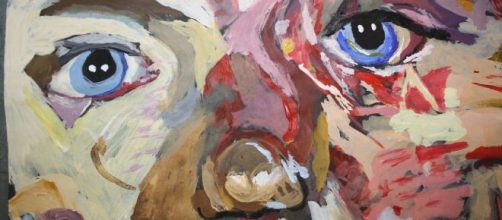Hollywood and high art usually command different worlds.
But Roger Ebert’s opening salvo reviewing the 1981 movie “Mommy Dearest” speaks for me seeing publicity photos for Jenny Saville’s drawing and painting show “The Mothers” at the Museo degli Innocenti in Florence. Ebert said, “I can’t imagine who would want to subject themselves to this…”
Thoughts of a distressed Joan Crawford shrieking at her daughter, “No more wire hangers” popped to mind on looking at Saville’s fretful face and figure. Her agitation is made all the more striking with the display alongside Renaissance paintings of the Madonna and Child by the likes of Botticelli and Michelangelo.
Apples and oranges
“The Mothers” exhibit leaves you questioning the reason to hang worshipful paintings of the Virgin Mary next to unsacred paintings. One is lofty and still while the other is fleshy and flustered. There’s no comparison. They don’t belong in the same room.
Continuity News quotes the curator of the Florence show, Sergio Risaliti explaining that the Renaissance was dominated by men. “Putting a female artist on equal footing” was warranted, he said. What’s more, he added, because the Renaissance was avant-garde (it rebelled against medieval art), Seville’s work is “sending a message of the importance of the avant-garde today.”
'Mommie Dearest'
But wait, the only thing “avant-garde” apparent in Saville’s work is her joyless look at motherhood.
Continuity News’ take on “The Mothers” not only notes the artist’s agitation, but also her “bruised or ruptured skin — not the body beautiful, but the suffering, anxious and impermanent body.”
After reading that assessment, you don’t expect Continuity News to sum up “The Mothers” with the headline: “Jenny Saville’s Nudes Bring Renaissance Masters Down to Earth.” Is that what Saville’s tormented pictures amount to - no-nonsense imagery? Does that mean Old Master paintings of the Virgin Mary are pretentious and ostentatious?
Gender wars
When “The Mothers” was on view in 2011 at the Gagosian Gallery in New York, I found it repellant and opted out of reviewing it. Art critic Donald Kuspit braved the task; although his review in Art Forum was mystifying.
He said that Saville’s mothering imagery stood for the first stages of the gender wars, that the relationship between mother and male infant is “precarious and uncertain.”
Citing one image called Pentimenti IV, Kuspit said he saw the mother's face “by no means loving – it even seems angry, or at least irritated and troubled.” It’s been a while since I gave birth to my son, but Kuspit’s descriptions don’t jibe with my memory any more than Saville’s do.
Granted, tending a newborn is not as quiet as Old Master images of Madonna and Child suggest. But it was never as “troubled” as Kuspit made it out to be. My infant was male, but mainly he was an infant.
In the words of Ebert again, “I can’t imagine who would want to subject themselves to this (show).”


